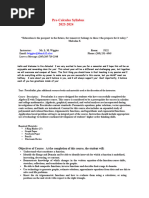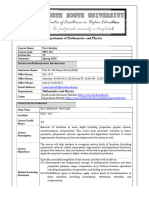DirectFileTopicDownload 2
Uploaded by
nikkimukkar11DirectFileTopicDownload 2
Uploaded by
nikkimukkar11MISSISSAUGA SECONDARY SCHOOL
MATHEMATICS DEPARTMENT – Grade 11 Functions
(University Preparation)
Course Code: MCR3U0 Pre-requisite: MPM2D0
Workbook: Functions 11 ($12.00 replacement)
Course Description Course Breakdown:
This course introduces the mathematical concept of the function
by extending students’ experiences with linear and quadratic Unit 1: Characteristics of Functions
relations. Students will investigate properties of discrete and
continuous functions, including trigonometric and exponential Unit 2: Exponential Functions
functions; represent functions numerically, algebraically, and
graphically; solve problems involving applications of functions; Unit 3: Trigonometric Functions
investigate inverse functions; and develop facility in determining Unit 4: Discrete Functions
equivalent algebraic expressions. Students will reason
mathematically and communicate their thinking as they solve Assessment and Evaluation - Key Terms and Definitions:
multi-step problems. Successful completion of this course
prepares students for Grade 12 Advanced Functions (MHF4U0). Assessment for Learning: The ongoing process of gathering
Overarching Learning Goals: and interpreting evidence about student learning for the
1. Students develop an understanding of the concept of a purpose of determining where students are in their
function through the investigation of their graphical and learning, where they need to go and how best to get there
algebraic representations including the effects of (e.g. diagnostic pieces, observations, conversations,
transformations and applying inverses. assignments, concept maps, interviews and progress
2. Students reason mathematically the concept of equivalence monitoring). The information gathered is used by teachers
as it relates to simplifying polynomial, radical and rational to provide feedback and adjust instruction to help students
and exponential expressions focus their learning. Assessment for learning is a high-yield
3. Students reflect on the meaning of periodic relationships and instructional strategy that takes place while the student is
make the connection to sinusoidal functions, being able to still learning and serves to promote learning.
represent these functions in numeric, graphical and algebraic Assessment as Learning: The process of developing and
ways. supporting student understanding of their own learning.
4. Students explore the difference between continuous and Students are actively engaged in this assessment process:
discrete functions and use their understanding to identify that is, they monitor their own learning (e.g. metacognitive
and model algebraically various types of discrete functions questions, journals and self-assessment, problem solving
including arithmetic, geometric and recursive. templates, interviews, conferences); use assessment
5. Students make connections between the various types of feedback from teacher, self, and peers to determine next
functions they have learned and the real-life applications steps; and set individual learning goals. Assessment as
that can be modelled by them such as, exponential growth learning requires students to have a clear understanding of
and decay, financial applications, and sinusoidal applications the learning goals and overall expectations as specified in
to periodic phenomena the curriculum document.
Course Weighting
Assessment of Learning: The process of collecting and
interpreting evidence for the purpose of summarizing
learning at a given point in time, to make judgements about
Final Evaluation Knowledge and
30% Understanding the quality of student learning on the basis of established
25% criteria, and to assign a value to represent that quality (e.g.
quizzes, tests, presentations, projects, problem solving
tasks). The information gathered may be used to
communicate the student’s achievement to parents, other
teachers, students themselves and others. It occurs at or
near the end of a cycle of learning. These measures will
Application contribute to pivotal decisions that will affect a student’s
Thinking 25%
15% future pathways.
For more information, please refer to the Ontario
Communication
5% Ministry of Education Grade 11 Curriculum Outline at:
http://www.edu.gov.on.ca/eng/curriculum/secondary/math1112currb.pdf
MISSISSAUGA SECONDARY SCHOOL – Grade 11 Functions
Achievement Chart Category Evidence of Learning
Observations Conversations Products
Knowledge
Knowledge of content (e.g., facts, terms, use of tools) Participation Peer conferencing Quizzes
Understanding of mathematical concepts
Thinking Problem solving Student-teacher Unit Tests
Use of planning skills group work conferencing
- understanding the problem Assignments
- making a plan for solving the problem Informal Group work
Use of processing skills Presentations Summative Tasks
-carrying out a plan Classroom
- looking back at the solution Interpretation contributions Final Exam
Use of critical/creative thinking processes Skills
-reason mathematically to solve multi step problems Response Journals
Communication Written
-Expression and organization of mathematical ideas and expressions Presenting
thinking, using pictorial, graphic, dynamic, numeric, solutions
algebraic forms and concrete models Listening and
-Communication for different audiences and purposes in speaking skills Responding to
oral, visual, and written forms questions
-Proper use of conventions, terminology and symbols Self-assessment
Application Asking relevant
-Application of knowledge and skills in familiar contexts Appropriate use of questions
-Transfer of knowledge and skills to new contexts manipulatives
- and between various contexts (e.g., between concepts
and forms within mathematics; involving use of prior
knowledge and experience; connections between
mathematics, other disciplines, and the real world)
STUDENT ASSESSMENT, EVALUATION, AND REPORTING IN PEEL SECONDARY SCHOOLS
Success Criteria for completing this course:
Learning Skills: Each student is assessed not only on their academic achievement but also on their Learning Skills. These skills
include: Responsibility, Organization, Independent Work, Collaboration, Initiative, and Self Regulation. Learning skills will not be
factored into the grade for this course but will appear on the report card. It is important to remember that the development and
consistent practice of these skills will influence academic achievement.
Attendance & Punctuality: Regular attendance to scheduled classes, and active participation in learning activities, will provide
students with the experiences necessary to successfully complete this credit. Attending classes on time will ensure that there are
no gaps in the student’s learning, demonstrate commitment to learning, and respect for self & others. Please refer to the student
agenda for more information regarding the Attendance and Punctuality Policy.
Homework Completion: Consistent homework completion is essential for student success. Although students will be given some
class time to initiate their homework, they should expect an average of 60 minutes of homework each night. Students should use
unit outlines to plan effectively, manage time efficiently, and work ahead, if possible. Homework will be monitored according to
your teacher’s instruction. Students should seek support as soon as possible when having difficulty with daily homework.
Missed Evaluation: Students will be given ample notice regarding the date for an evaluation. Students who are aware that they
will be absent must discuss the situation with their teacher prior to the absence or will not be given an opportunity to rewrite. An
unexpected absence for a legitimate reason may require parent support. Upon approval, the student may be given an opportunity
to write an alternate evaluation at the teacher’s convenience, at a specified date and time.
Late and Missed Assignments: Please see the Policy on Absence of Evidence of Student Achievement outlined in the student agenda
Plagiarism and Cheating: Please see the Policy on Plagiarism and Cheating outlined in the student agenda
Homework, Assignments and Effective Communication: To earn a credit students have a responsibility to submit sufficient
evidence of understanding within established deadlines. It is in the student's best interest to submit evidence of learning at every
opportunity that is provided, so that his/her grade accurately reflects what was learned. If a student produces insufficient evidence
in the key understandings for the course, the entire credit is at stake.
Student Signature: _____________________________________
Parent Signature: ________________________________ Please Circle Relationship: Father/Mother/Legal Guardian
You might also like
- A Practical Algorithm For Decomposing Polygonal Domains Into Convex Polygons by DiagonalsNo ratings yetA Practical Algorithm For Decomposing Polygonal Domains Into Convex Polygons by Diagonals21 pages
- Foundations of Algebra Syllabus Fall 2017No ratings yetFoundations of Algebra Syllabus Fall 20174 pages
- Precalculus, Mathematics For Calculus by Stewart, Redlin, Watson Brooks/Cole ©2016 Seventh EditionNo ratings yetPrecalculus, Mathematics For Calculus by Stewart, Redlin, Watson Brooks/Cole ©2016 Seventh Edition6 pages
- MCR3U Course Outline and Policies-Jan 2024No ratings yetMCR3U Course Outline and Policies-Jan 20243 pages
- Fdocuments - in - Myp Unit Planner Wikispaces Li Unitplansolveequationwhich Specific MypNo ratings yetFdocuments - in - Myp Unit Planner Wikispaces Li Unitplansolveequationwhich Specific Myp5 pages
- New York City College of Technology The City University of New YorkNo ratings yetNew York City College of Technology The City University of New York10 pages
- 2023-2024 Syllabus Algebra I - Lexi MireeNo ratings yet2023-2024 Syllabus Algebra I - Lexi Miree5 pages
- mbf3cb Course Outline 2015 Sem2 CstewartNo ratings yetmbf3cb Course Outline 2015 Sem2 Cstewart3 pages
- Learning Environment Standard 18 Assessment: Descriptive StatementNo ratings yetLearning Environment Standard 18 Assessment: Descriptive Statement25 pages
- Learning Environment Standard 18 Assessment: Descriptive StatementNo ratings yetLearning Environment Standard 18 Assessment: Descriptive Statement25 pages
- Iloilo Science and Technology University: Republic of The Philippines Miag Ao Campus Miag Ao, IloiloNo ratings yetIloilo Science and Technology University: Republic of The Philippines Miag Ao Campus Miag Ao, Iloilo13 pages
- Adept Material Assessment and Evaluation in MathematicsNo ratings yetAdept Material Assessment and Evaluation in Mathematics78 pages
- Mathematics: National Curriculum Statement Grades 10-12 (General)No ratings yetMathematics: National Curriculum Statement Grades 10-12 (General)39 pages
- Mathematical Literacy Grades 10 - 12 EditedNo ratings yetMathematical Literacy Grades 10 - 12 Edited39 pages
- TMS3725 - TL201 - Assignment 4 - 2022 PDFNo ratings yetTMS3725 - TL201 - Assignment 4 - 2022 PDF4 pages
- Assessment and Evaluation in Mathematics Prelim100% (3)Assessment and Evaluation in Mathematics Prelim19 pages
- Prelims - Chapter 2: Mathematics Language and SymbolsNo ratings yetPrelims - Chapter 2: Mathematics Language and Symbols30 pages
- Digital Image Watermarking Using D.W.T: By: Ashish Kumar (09407) Abhilasha Verma (09401No ratings yetDigital Image Watermarking Using D.W.T: By: Ashish Kumar (09407) Abhilasha Verma (0940117 pages
- ACRES 3255 - Session-5 - Research Methodology and Statistical ToolsNo ratings yetACRES 3255 - Session-5 - Research Methodology and Statistical Tools12 pages
- Cluster University of Jammu: (Examination To Be Held in 2017, 2018 and 2019) Title: Logic, Sets & RelationsNo ratings yetCluster University of Jammu: (Examination To Be Held in 2017, 2018 and 2019) Title: Logic, Sets & Relations2 pages
- Mathematical Aptitude Model Test Paper For MBA100% (1)Mathematical Aptitude Model Test Paper For MBA5 pages
- Chapter 10 - Grain Growth, Sintering and VitrificationNo ratings yetChapter 10 - Grain Growth, Sintering and Vitrification34 pages
- Interaction Formula:: 1.0 resistance effects load ΣNo ratings yetInteraction Formula:: 1.0 resistance effects load Σ20 pages
- Control Engineering - A Practical GuideNo ratings yetControl Engineering - A Practical Guide124 pages
- From Gatekeeper To Gateway: The Role of Quantitative ReasoningNo ratings yetFrom Gatekeeper To Gateway: The Role of Quantitative Reasoning8 pages
- AB Memory Based IBPS PO PRE Quantitative Aptitude - 3rd Oct 2020No ratings yetAB Memory Based IBPS PO PRE Quantitative Aptitude - 3rd Oct 202024 pages
- August 15. Angles - in - Triangles ProblemsNo ratings yetAugust 15. Angles - in - Triangles Problems5 pages
- Predicting Inflation With Neural Networks: Livia ParanhosNo ratings yetPredicting Inflation With Neural Networks: Livia Paranhos47 pages

























































































